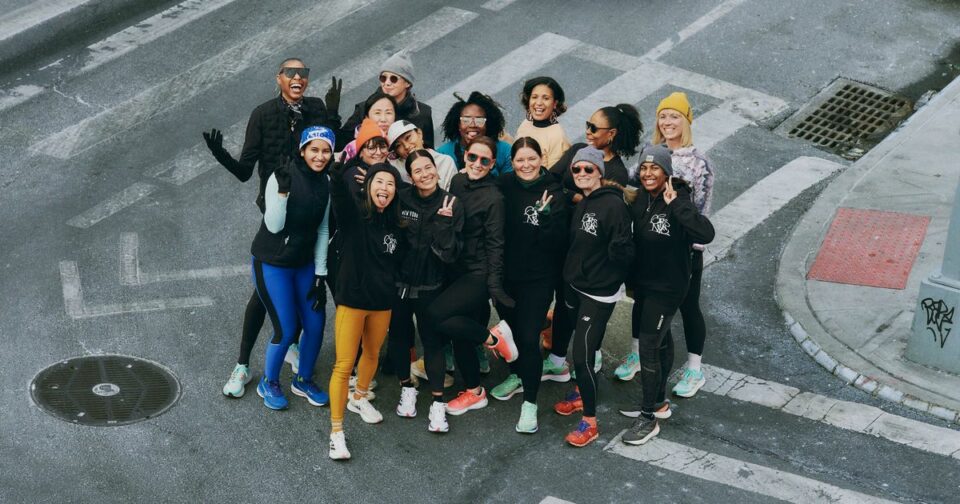
Running is often a solitary act, an unfurling of limbs propelled by fear or courage or some other fiery feeling. At first glance, it requires little beyond time, a pair of shoes (even those are not essential, pending terrain), and a body that is willing. For longer ventures or intensive sprints, running necessitates planning: rationing energy, balancing tenacity with rest. Motivational quotes about the sport tend to be paired with stock photos of sunrises and sunsets, a reminder that a running routine can be miraculous.
There are, of course, infinite reasons why a person might be hesitant to run, especially in New York City. When she launched Girls Run NYC in 2014, creative-arts psychotherapist and runner Jessie Zapo wanted to make it easier for women of all abilities to run “in fellowship with others,” whether they’re novices or professional athletes. At first, her idea was to host a “pop-up run.” Soon after, it became a weekly Wednesday-night event at McCarren Park Track, and through winter, takes place along the Williamsburg Bridge. “It was created as a meetup, just a way to bring all these women together, even if they belonged to other running clubs or communities,” says Zapo. “I had been co-leading in quite a few coed groups and saw there was this intimidation factor. A lot of women were concerned about being new, not fast enough, not looking like a runner, not knowing enough … Our goal was to create a space where it didn’t feel scary, and you weren’t going to show up and get left behind in the dust.”

Soon after founding Girls Run, Zapo completed her USA Track and Field Coaching certification. She enlisted two close friends as co-captains, Rasheda Herndon and Ameerah Omar. (“The three of us equally lead,” Zapo says.) Over the last ten years, the group has exploded beyond weekly track runs. They’ve organized trips to Iceland, Copenhagen, Berlin, Toronto, Los Angeles, and Phoenix to race half-marathons and ultramarathons and everything in between. They’ve hosted fundraisers for a local women’s shelter and the Women’s Prison Association. They’ve trained women for their first ultramarathons at Black Canyon Ultras in Arizona and beyond, and coached others to run their first mile. Midway through the Berlin Marathon, two athletes rang Herndon—who Zapo describes as “a lifeline” to many—for a pep talk. “I had my phone by my ear,” Herndon says of one conversation, even though it was the middle of the night. “I was ready for that call. I gave her a swift little kick in the butt.”
The essence of Girls Run is the Wednesday meetup, a format simple enough to be sustainable. Most of the year, the park’s track offers a contained environment. The trio — Zapo, Herndon, and Omar — show up at 6 p.m., whatever the weather. There are introductions, then a warm-up and drills, followed by an interval workout, where attendees can feel things out based on their natural pace and ability. This is framed as a “challenge by choice” — anyone is welcome to sit out — followed by a cooldown and stretching. “We don’t take membership fees,” Zapo says. “We don’t take sponsor money. It’s a space we have total ownership over, so we don’t have to do what a brand wants us to.”
There’s no official way to become a member of Girls Run — people come and go and often return after a spell away. Zapo used to monitor attendance but decided it wasn’t necessary to keep tabs on the runners in such a rigid way. Within a single year of roll call, hundreds had run with the group. “We’re often a place for women who are in their 20s and early 30s, trying to make it in the city,” says Zapo. “They’re looking for a space to have fellowship, maybe get some guidance, to feel like they belong somewhere. I think the three of us were all those women at one point — in the city at a young age, just trying to get by. I remember feeling everything was so inconsistent in New York … that the one consistent thing I had was this running group.”
Around 2016, Chiyo Yamauchi, a journalist and editor who’d arrived in New York from Tokyo, profiled Girls Run for a Japanese publication. “At the time, I was not a runner at all,” she says. “Even though they kindly asked me to join, I couldn’t picture myself running.” During the pandemic, her priorities shifted. “I was drawn to the inherent accessibility of running, a sport that one can initiate and sustain effortlessly.” She reconnected with the group and has been running with them since. “As someone who had never been naturally inclined toward social interactions and struggles with the nuances of small talk — compounded by the language barrier — I encountered initial challenges,” she says. “Despite my reserved nature, I found myself embraced.”
By Laura Bannister , 2024-03-29 17:00:25
Source link


